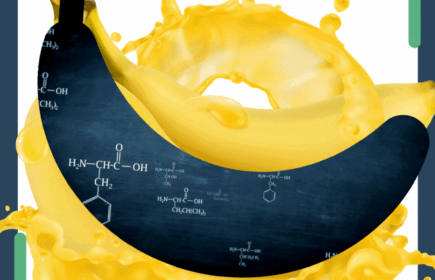What some of you might not know about me, is that I am a NERD. Oh sorry, you know that already from my other blogs, I meant I am married to one, and we enjoy having very nerdy conversations at home. Warren, my husband, is a high school science teacher with a degree in chemistry. Since I do a lot of work in understanding science and the chemistry behind many of our foods and agricultural inputs, it leads to many discussions about chemical literacy. I know, cool! I think it’s cool to understand the composition of the things around us, especially since we often hear that chemicals are bad for us. So, let’s get cool and talk chemical literacy.
My science bias
Before we dive too deep, let me first be upfront: I am not SUPER literate when it comes to chemicals. I am just very curious, so when I do not know something, I look it up. Part of that is because I am married to this cool dude, and I want to be able to ask him questions and understand what he is talking about. Also, I am a strong believer in science and our regulation policy here in Canada, so when it comes to talking about chemicals, whether it is for agriculture or the composition of our food, I am biased to trust the science and safety behind it.
The Chemistry of Life
It’s all chemical. All matter is composed of substances which are identified as chemicals. The matter all around us is composed of different chemical elements that are arranged in different combinations or ratios. In total, there are 118 chemical elements (only 92 naturally occurring, the rest man-made!), and when they combine through different chemical reactions, we get different products. H2O is water, and it is the composition of 2 hydrogen atoms with 1 atom of oxygen. Everything is composed of chemicals, but some are more complex than others and that can make them more difficult to understand. 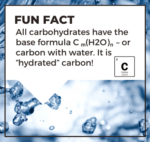
- Sucrose (sugar) is C12H22O11 which is a ratio of 6 carbon: 22 hydrogens: and 11 oxygen.
- Steel doesn’t have just one set chemical formula, but it is the combination of iron and carbon, along with other metals and sometimes alloys.
- Diamonds are pure carbon, formed by extreme heat and pressure.
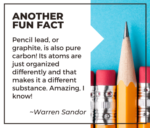 Living organisms are mostly made up of carbon, hydrogen, oxygen, and nitrogen (CHON), which make up 95% of the mass of the organism. The human body is roughly 65% oxygen, 18.5% carbon, 9.5% hydrogen, 3.5% nitrogen, and 3.5% other chemical elements like calcium, phosphorus, and other 15 others.
Living organisms are mostly made up of carbon, hydrogen, oxygen, and nitrogen (CHON), which make up 95% of the mass of the organism. The human body is roughly 65% oxygen, 18.5% carbon, 9.5% hydrogen, 3.5% nitrogen, and 3.5% other chemical elements like calcium, phosphorus, and other 15 others.
Chemical Literacy
So, what Is chemical literacy? I am not suggesting you need to remember back to your high school years and know about stoichiometry or thermodynamics calculations in our daily life – that’s not being chemically literate for the everyday user. It is really about knowing enough to make good decisions in your daily life, understanding marketing and propaganda tactics, and knowing when to be afraid and when not to be afraid. This is a higher-value skill for the average person.
In other words, chemical literacy is being able to understand and use chemistry in everyday life. It involves three main parts: knowing chemistry, being aware of its importance, and applying it effectively. When it comes to chemical literacy, there is well-documented research on the topic by Schwartz et al al. in three of their publication in 2006a, b, and 2011. These authors review literacy and what it means at a high school level, which is where most of us get introduced to the topic, but also where many of us last learn about it. From their research, they divide chemical literacy into four segments:
- scientific and chemical content knowledge,
- chemistry in context,
- higher-order learning skills, and
- affective aspects.
However, that isn’t very clear, and not even my husband who is chemically literate understood what was meant by “affective aspects”. So maybe we shouldn’t focus on what the ‘academic’ research world thinks of chemical literacy, and maybe more on the practical side of it all. When I refer to chemical literacy, I am more focused on being aware of its importance and having the content and context (1 and 2) to understand what I am being presented with. Everything is composed of chemicals, and therefore understanding them can’t hurt. I hear all the time, even from my friends and family, about eating only “clean ingredients” or if you can’t read (or pronounce) it, you shouldn’t eat it. Oh, this one grinds my gears, first of all, because I am really poor at reading (I am a phonetic reader), but also because this is just silly! Food labels are not written with chemical elements listed, they are written according to their ingredient or chemical names, like sucrose, and not C12H22O11.
Going bananas for chemicals
Let us take a simple example, the banana. Now if a banana were to have a food ingredient label, it would say 100% banana, and if it were an ingredient in another food, it would be listed simply as banana. Easy, right!? But what if you listed the composition of that banana what would that label look like?
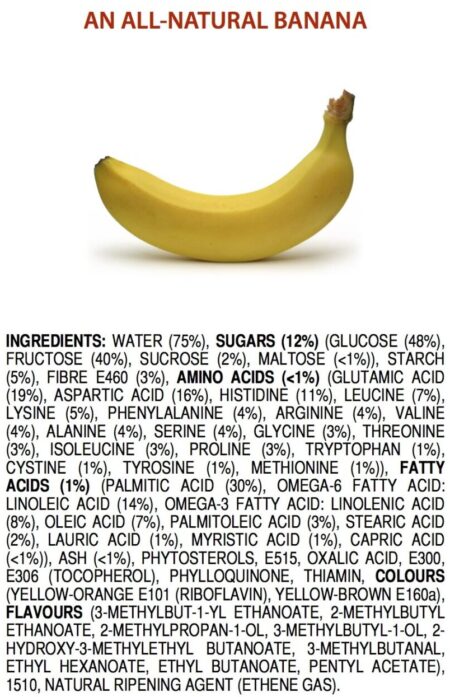
James Kennedy, a chemistry teacher and author has a great source of infographics on his website which breaks down the ingredients of a banana, not the chemical composition but what would be the ingredient name. We know that bananas are safe to eat, but if you were to live by the mantra of if you can’t pronounce it you shouldn’t eat it, would you eat it? Can you pronounce phenylalanine or phylloquinone? Phenylalanine is an amino acid (C9H11NO2) that is used to make protein. Without it – no muscles, cartilage, bones, or cells. What about phylloquinone, whose chemical formulation is C31H46O2 and is described as 2-methyl-3-(3,7,11,15-tetramethylhexadec-2-enyl)naphthalen1dione? Good luck saying that! It is vitamin K1, a fatty acid which is needed for “blood coagulation and bone metabolism”.
Of course, we know that bananas are safe to consume, but this just aids in the argument that we need to question the chemical literacy we are presented with and work to understand what is being presented to us. So, whether it’s a banana or a complex list of ingredients, they are both composed of multiple chemicals, but that doesn’t mean it is bad or good either.
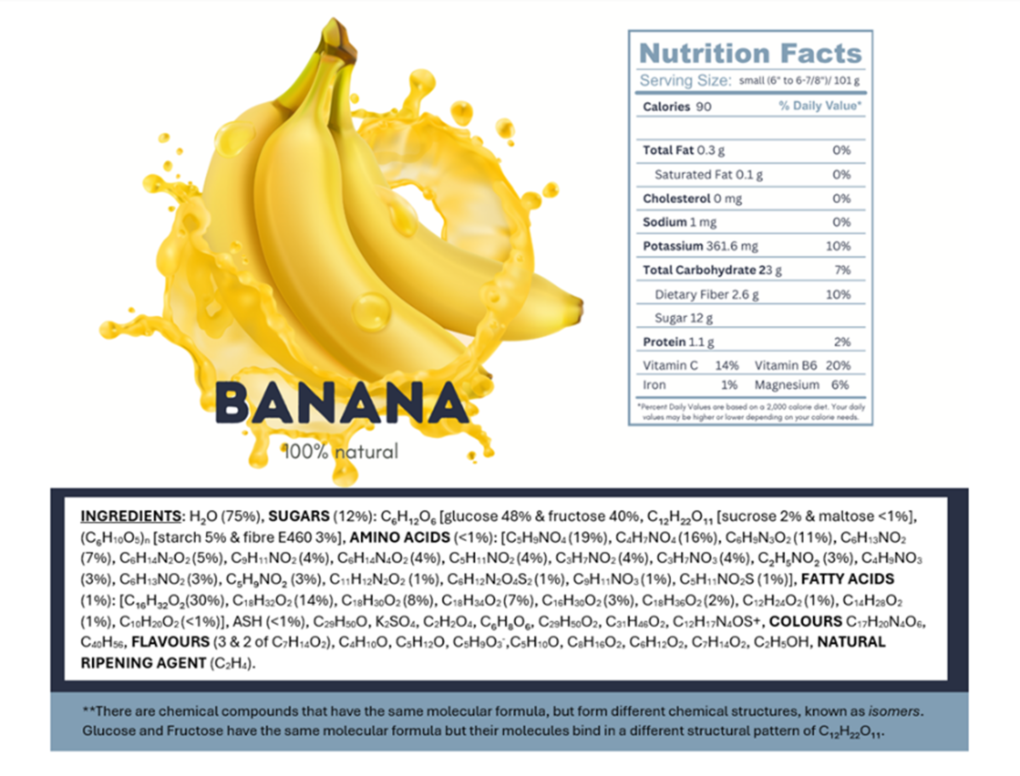
Savannah Gleim, 2024
How do I become chemical literate?
We live in an age where there is so much information and also too much access to misinformation, that I don’t think it is your responsibility to become chemically literate. Do I think it would be beneficial? Sure, but I also know it would be beneficial if I learned to change my own oil or how to skate backward, but I am 36 years old and haven’t yet and I am getting by just fine. It is the steps within being chemical literate that I think are important.
First off, knowing that everyone and everything is composed of chemicals is good to acknowledge. It helps us remember that chemicals are not bad. As explained by my husband, “few chemicals are inherently bad for you, chemical safety is almost always about how much”. Many are bad for you if you get too much, and some (like vitamins for example) are bad for you if you get too little, but this is a topic for a future blog. Next, when you are curious or are presented with the idea that the chemicals of something are either good or bad for you, it’s important to ask why. What makes it good or bad, and taking the time to inquire about it, is helping to gain chemical literacy.
Behind the Blog:
Gratitude, Inspiration, and a Nerd
First off, a huge thanks to my husband, Warren. Not only was he a good sport about me calling him a nerd and sharing his dupe mug with the internet, but his feedback and input on this blog were invaluable. Honestly, we’ve talked so much about this topic that it was hard to decide what to include (and even harder to figure out what to leave out—spoiler: a lot).
This post was also inspired by something I came across a few weeks ago on Dr. Cami Ryan’s LinkedIn page. She shared a 1980s Monsanto ad with the bold tagline: “Mother Nature is lucky her products don’t need labels.” That line stuck with me. It’s true—raw, natural products often escape the scrutiny of labels, which can be a marketing advantage today. But it also underscores the need for the agriculture and science industries to build trust. Consumers deserve transparency and confidence in what’s on their labels and the chemistry behind it.
Finally, I want to thank you for taking the time to read this post. While it’s not directly about sustainability, agriculture, or innovation, it does touch on a food-related topic that feels just as relevant. My goal isn’t to suggest anyone needs to be more educated—I’d never approach it that way—but rather to spark curiosity. I hope this encourages you to explore your own understanding of chemicals and how they intersect with your daily life.
Because at the end of the day? It’s all chemistry. 🌟
~Savannah


